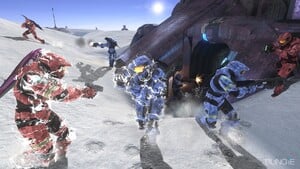Energy shielding
From Halopedia, the Halo wiki

Several United Nations Space Command, Covenant and Forerunner vehicles, devices, and armor systems make use of energy shielding to protect users from harm. Energy shields consist of a field of energized particles that wraps around a surface, which deflects objects that attempt to impact the surface.
Human energy shielding
Humans have used energy shield technology for a relatively brief amount of time. The earliest known example is the "bubble shield", a protective device developed and deployed by the Office of Naval Intelligence's Beta-5 Division,[1] which has been in service since at least 2544.[2] The Beta-5 Division also utilizes the "drop shield", a similar device which, despite being less resilient than the bubble shield, is capable of regenerating organic tissue through unknown means.[1]
Near the end of the Human-Covenant War, ONI scientists successfully reverse-engineered the technology used in Kig-yar point defense gauntlets, leading to the technology's incorporation into the Mark V MJOLNIR Powered Assault Armor and all later iterations of the series. Energy shielding technology had previously been tested with the Grenadier variant of the MJOLNIR Powered Assault Armor/Mark IV,[3] though these tests were not successful.[4] The UNSC also reverse-engineered an "armor lock" plug-in module from functionally identical Covenant technology. In conjunction with the MJOLNIR armor's lock-down system, this device emits an impervious shield barrier that can deflect all small arms fire and can shed attached plasma grenades. The SPARTAN-III Headhunters wear an advanced version of the standard-issue Semi-Powered Infiltration Armor which features energy shields that are similar to those of MJOLNIR, though the shields share power with the suit's active camouflage module.[5]
The UNSC also uses "shield doors", which were installed on the refit platform Anchor 9 and in atrium of the Office of Naval Intelligence's Alpha Site. One of the UNSC's most recent breakthroughs in energy shield development came with the creation of the YSS-1000 Sabre starfighter, which is the first human spacecraft known to use energy shields.
Covenant energy shielding
The Covenant make extensive use of energy shielding technology. Nearly all Covenant starships larger than a corvette use energy shields and several ground-based structures use shields as well. Many Covenant warriors are equipped with energy shields.
Personal shielding
Most Sangheili, many Jiralhanae, and some high-ranking Yanme'e are equipped with energy shields that are integrated into the wearer's armor, or, in the latter case, carapace. Kig-yar warriors use energy shield gauntlets that protect them from most oncoming fire but leaves them vulnerable to flanking attacks and grenades. The Covenant often use Huragok to provide energy shielding to troops on the battlefield. The Covenant also utilize overshields, which provide additional layers of energy shielding to the wearer, and energy shield regenerators. Sangheili and Jiralhanae warriors sometimes use armor lock systems, from which the UNSC technology was reverse-engineered; Jiralhanae are able to use this technology even without power armor.
Though the Hierarchs are not meant to encounter combat, their gravity thrones emit powerful energy shields. They are able to deflect all forms of projectile, plasma, and explosive weaponry and seemingly never become depleted. However, one can simply walk through the shield. The shield used by Tartarus, the Chieftain of the Jiralhanae, was much different and seems to have to be actively turned on. His shield could deflect nearly all attacks save for those of a captured beam rifle. A similar, though much less potent technology is often used by Jiralhanae chieftains; this "invincibility" device lasts only a matter of seconds, though it renders the user impervious to small arms fire. The device can also be used by personnel who do not otherwise possess energy shielding, such as UNSC Orbital Drop Shock Troopers.[6]
Starship and single ship shielding
Nearly all Covenant vessels are protected by highly resistant energy shields. These shields can withstand an impressive amount of firepower and can recharge very quickly. Covenant vessels' shields can absorb almost all missile fire, including hundreds of Archer missiles and even a low-yield Shiva-class nuclear missile, although Shiva nukes will usually deplete their shields, making them vulnerable to smaller weapons. The only UNSC weapons capable of penetrating a Covenant starship's shield are the Magnetic Accelerator Cannons. Even then, ship-based MACs take multiple rounds to drop the shields; only a "Super MAC" round from an orbital defense platform can penetrate a Covenant ship's shields in one hit.
Covenant starship shielding does have a notable flaw, however: Whenever a starship launches a plasma torpedo or pulse laser, a small section of the energy shield must drop to allow the weapon to fire. Otherwise, the energy released would detonate on the inside of the shields, damaging the ship.
While projectile weaponry is generally ineffective against Covenant starship shielding, directed energy weaponry can disable shields with relative ease, in much the same manner as Sangheili energy shields. Another way to disable the shipboard energy shields is through the use of a large-scale electromagnetic pulse.[7]
The Covenant's Type-31 "Seraph" fighters are typically equipped with energy shields, though this does not seem to always be the case.[2] Phantom gunboats are equipped with powerful shields that can deflect cannon fire but are vulnerable to missiles due to their lower velocity.[8]
The Covenant also use energy shields as hangar bay doors. These devices prevent the evacuation of atmosphere from the hangar bay and deny unwanted entry and exit. They can be phased in such a manner that atmosphere remains in the hangar bay while single ships can enter the vessel.[8]
Vehicle shielding
Few Covenant ground vehicles are equipped with energy shields. The most notable exception is the Locust, a repurposed mining platform that is used as a "building killer". The Locust emits a spherical shield that can resist most high-impact projectiles. However, this shield is rather weak and will dissipate under concentrated fire, exposing the Locust's vulnerable hull. Type-32 "Ghost" assault vehicles and Type-26 "Wraith" tanks, while almost universally unshielded, can be retrofitted with energy shields that deflect most projectiles.
Stationary shielding
The Covenant make extensive use of stationary energy shield devices. One of the most common is the energy barrier, which is used to cordon off restricted areas and to deny enemy movement within invaded cities.[9]. This technology can also be used to form anti-vehicle barriers; though vehicles and projectiles are repelled by these barriers, human and Covenant soldiers can pass through them on foot.[10][11] Smaller-scale barriers, including man-portable ones, are often used to provide cover during firefights.
Pre-fabricated Covenant bases are often outfitted with shield generators; multiple shield generators can be installed at a base to provide incrementally greater protection.[12] The Covenant sometimes use enormous energy shield domes to cover large areas, such as bases. These domes sometimes have no apparent power source,[13] though they are also used on teleportation spires, which are commonly used during invasions.[14] These shield domes are susceptible to high-intensity plasma.[13] While Covenant aircraft can pass through these shields unharmed,[13] UNSC aircraft that pass through the field receive a powerful electromagnetic pulse and suffer catastrophic systems failures.[14]
Some Shade turrets are equipped with energy shielding. Some lighter versions have only frontal shielding, while anti-aircraft models have multi-directional shielding.
Forerunner energy shielding
Many Forerunner constructs make use of energy shielding. Standard Forerunner Sentinels are encased within an ovoid energy shield that can withstand moderate damage, while the much more powerful Sentinels from the Onyx Shield World possess spherical golden shields that activate whenever a fast-moving projectile approaches. The larger Enforcers possess three-part energy shields that protect their photoreceptors and chassis from frontal assault, but do not protect against attack from any other angle.
The majority of Forerunner energy shields seem to consist of a translucent bubble composed of hexagonal patterns, as opposed to the wraparound shields typically used by the Covenant and UNSC.
The Forerunners made ubiquitous use of "hard light" technology, which could be shaped into any desired form, such as light bridges. It is possible that Forerunner energy shielding is derived from hard light technology.
Gameplay
- In Halo: Combat Evolved, the status of the energy shield is shown at the top-right corner of the screen above the health bar. In Halo 2, it is in the bottom-left above the motion tracker. In Halo 3, it is in the top-center of the screen. In Halo: Reach, it is shown in the top-center of the screen above the health bar.
- In multiplayer, players can have 50%, 100%, 200%, 300%, 400%, 500%, 1000%, or 2000% shield strength, or none at all. Both Elites and Spartans have the same amount of shielding. A player's shields can be further augmented if they pick up an overshield.
- In Halo: Combat Evolved under standard game settings, energy shields begin regenerating five seconds after last being hit and take four seconds to fully recharge from a total drain.
- In Halo 2 and Halo 3 under standard game settings, energy shields begin regenerating 4.25 seconds after last being hit, and take 1.75 seconds to fully recharge from a total drain.
Gallery
- A Sangheili's Shields.jpg
A Sangheili's personal energy shield overloading from sustained fire in the Halo: Reach Multiplayer Beta.
- Halo Reach UNSC Shields.jpg
A SPARTAN-III's energy shields flicker while taking damage from a Needler projectile.
A Spartan's and Elite's shield recharging in multiplayer.
- EliteShield.gif
List of appearances
Sources
- ^ a b Halo: Reach manual
- ^ a b Halo: Legends: The Package
- ^ Halo: Reach, The Armory
- ^ Dr. Halsey's personal journal
- ^ Halo: Evolutions - Essential Tales of the Halo Universe, Headhunters
- ^ Halo 3: ODST
- ^ Halo: The Fall of Reach, page 153
- ^ a b Halo: Reach, campaign level Long Night of Solace
- ^ Halo 3: ODST, campaign levels Mombasa Streets, Tayari Plaza, andKizingo Boulevard
- ^ Halo 3, campaign level Tsavo Highway
- ^ Halo Wars, campaign level Relic Approach
- ^ Halo Wars
- ^ a b c Halo Wars, campaign level Dome of Light
- ^ a b Halo: Reach, campaign level Tip of the Spear

